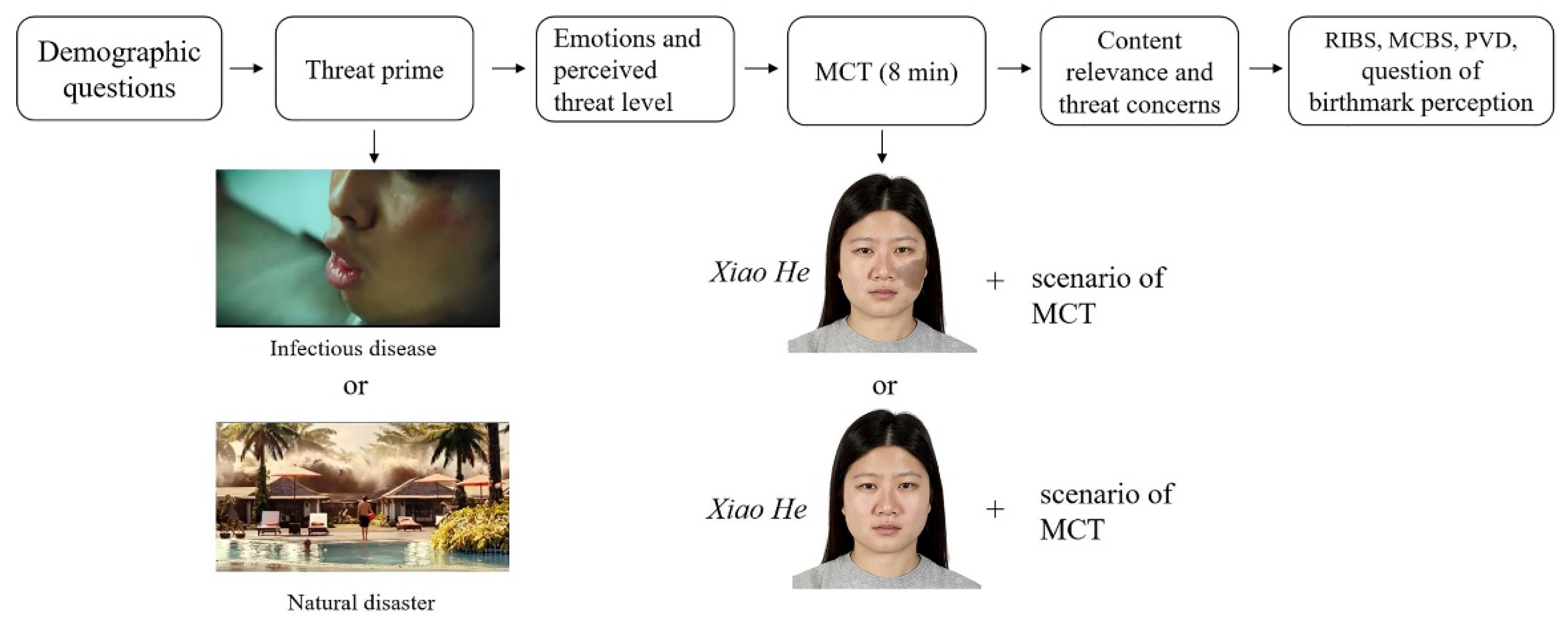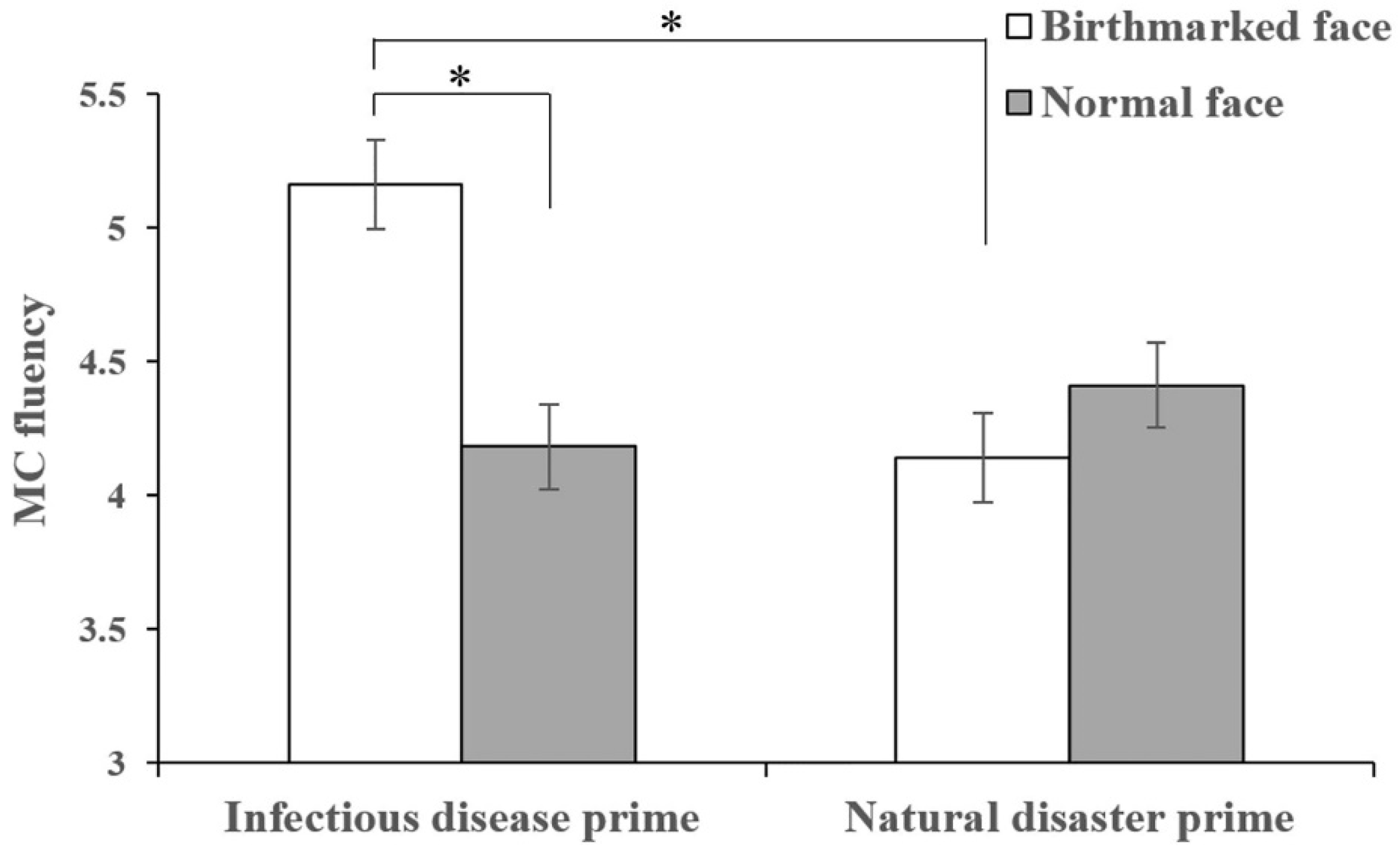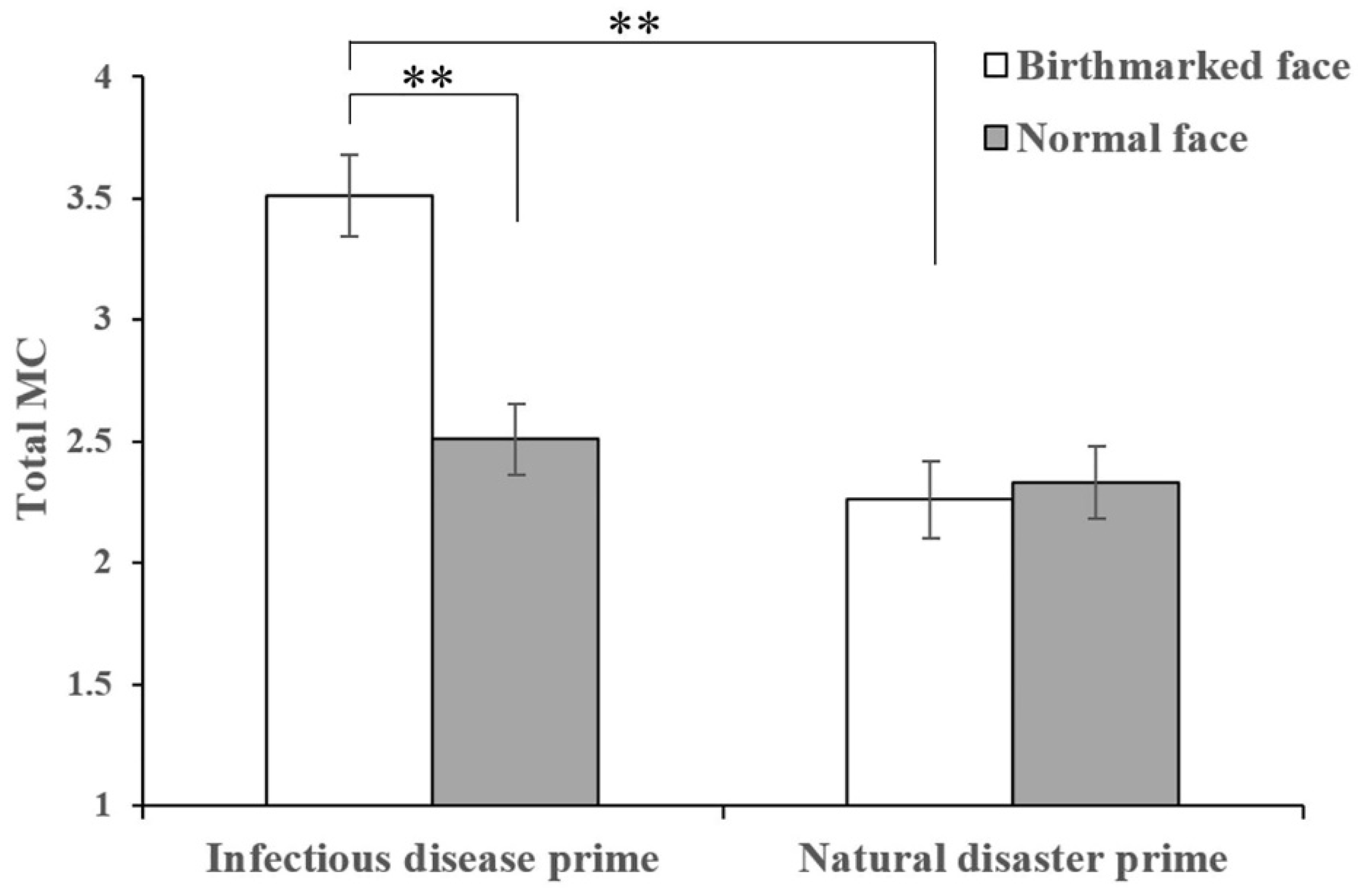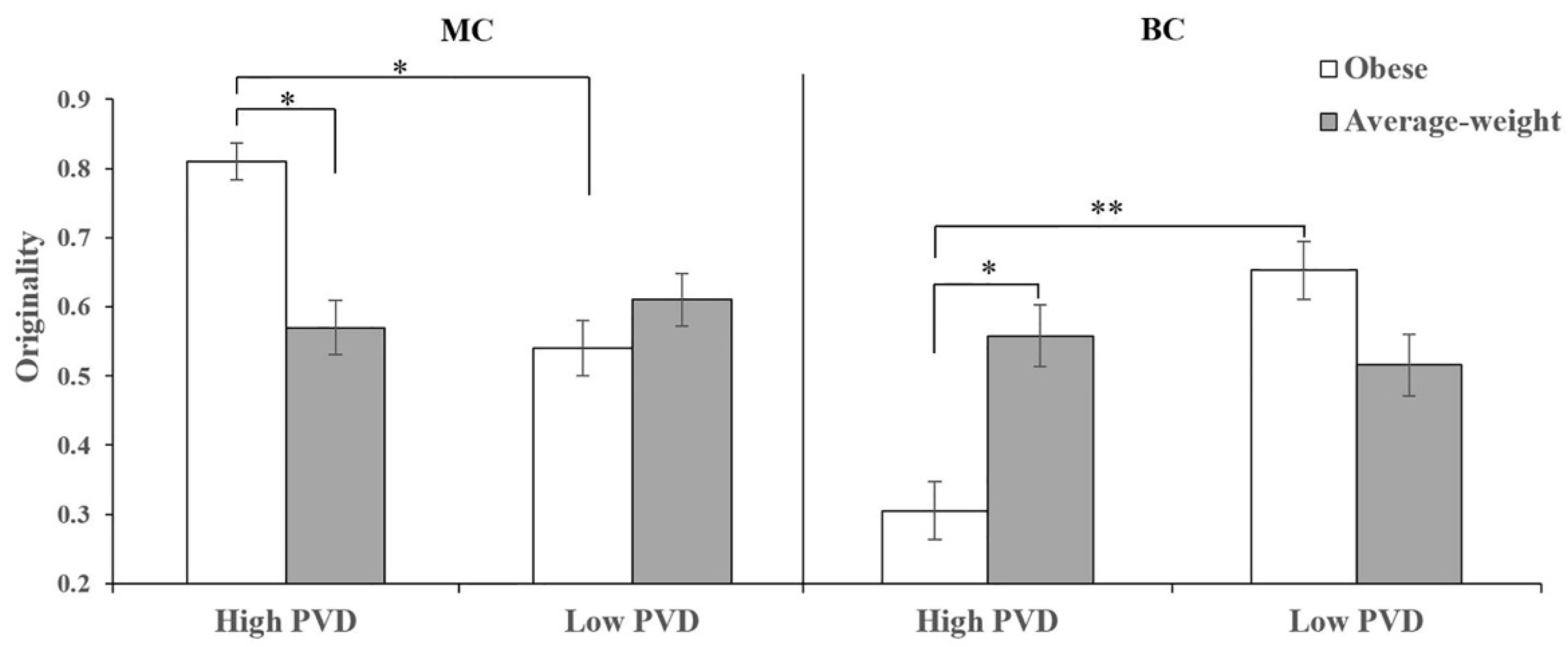The Effect of Infectious Disease Threat on Malevolent Creativity
Abstract
1. Introduction
2. Study 1
2.1. Experimental Design
2.2. Participants
2.3. Materials
2.3.1. Materials of Threat Prime and Manipulation Checks
2.3.2. Malevolent Creativity Task
2.3.3. Birthmarked Faces
2.3.4. Questionnaires
2.4. Procedure
2.5. Result
2.5.1. Manipulation Checks of Threat Prime
2.5.2. Malevolent Creativity
3. Study 2
3.1. Experimental Design
3.2. Participants
3.3. Materials
3.3.1. Pictures of Obese and Average-Weight Targets
3.3.2. Negotiation Task
3.3.3. Questionnaires
3.4. Procedure
3.5. Result
3.5.1. Effectiveness of Selecting High and Low PVD Participants
3.5.2. Creativity
4. General Discussion
5. Future Directions
6. Conclusions
Author Contributions
Funding
Institutional Review Board Statement
Informed Consent Statement
Data Availability Statement
Conflicts of Interest
References
- Ackerman, Joshua M., D. Vaughn Becker, Chad R. Mortensen, Takao Sasaki, Steven L. Neuberg, and Douglas T. Kenrick. 2009. A Pox on the Mind: Disjunction of Attention and Memory in the Processing of Physical Disfigurement. Journal of Experimental Social Psychology 45: 478–85. [Google Scholar] [CrossRef] [PubMed]
- Amabile, Teresa M. 1982. Social Psychology of Creativity: A Consensual Assessment Technique. Journal of Personality and Social Psychology 43: 997–1013. [Google Scholar] [CrossRef]
- Baas, Matthijs, Marieke Roskes, Severine Koch, Yujie Cheng, and Carsten K. W. De Dreu. 2019. Why Social Threat Motivates Malevolent Creativity. Personality and Social Psychology Bulletin 45: 1590–602. [Google Scholar] [CrossRef]
- Brown, Mitch, and Donald F. Sacco. 2020. Testing the Motivational Tradeoffs between Pathogen Avoidance and Status Acquisition. Social Psychological Bulletin 15: e2721. [Google Scholar] [CrossRef]
- Cheng, Rui, Lu Kelong, and Hao Ning. 2021. The effect of anger on malevolent creativity and strategies for its emotion regulation. Acta Psychologica Sinica 53: 847. [Google Scholar] [CrossRef]
- Cheng, Yujie. 2017. Creativity under the Gun: How Threat Features and Personal Characteristics Motivate Creative Responding. Ph.D. thesis, University of Amsterdam, Amsterdam, The Netherlands. Available online: https://dare.uva.nl/search?identifier=9e1d6a8e-654d-4938-b4a2-0bbebb4ff9da (accessed on 27 September 2022).
- Cheng, Yujie, Matthijs Baas, and Carsten K. W. De Dreu. 2018. Creative Responses to Imminent Threats: The Role of Threat Direction and Perceived Effectiveness. Journal of Experimental Social Psychology 74: 174–86. [Google Scholar] [CrossRef]
- Cropley, David H., James C. Kaufman, Arielle E. White, and Belinda A. Chiera. 2014. Layperson Perceptions of Malevolent Creativity: The Good, the Bad, and the Ambiguous. Psychology of Aesthetics, Creativity, and the Arts 8: 400–12. [Google Scholar] [CrossRef]
- Curtis, Val, Robert Aunger, and Tamer Rabie. 2004. Evidence That Disgust Evolved to Protect from Risk of Disease. Proceedings of the Royal Society of London. Series B: Biological Sciences 271 Suppl. 4: S131–S33. [Google Scholar] [CrossRef]
- De Dreu, Carsten K. W., and Bernard A. Nijstad. 2008. Mental Set and Creative Thought in Social Conflict: Threat Rigidity versus Motivated Focus. Journal of Personality and Social Psychology 95: 648–61. [Google Scholar] [CrossRef]
- Duncan, Lesley A., and Mark Schaller. 2009. Prejudicial Attitudes Toward Older Adults May Be Exaggerated When People Feel Vulnerable to Infectious Disease: Evidence and Implications. Analyses of Social Issues and Public Policy 9: 97–115. [Google Scholar] [CrossRef]
- Duncan, Lesley A., Mark Schaller, and Justin H. Park. 2009. Perceived Vulnerability to Disease: Development and Validation of a 15-Item Self-Report Instrument. Personality and Individual Differences 47: 541–46. [Google Scholar] [CrossRef]
- Giebels, Ellen, Carsten K. W. de Dreu, and Evert van de Vliert. 1998. The alternative negotiator as the invisible third at the table: The impact of potency information. International Journal of Conflict Management 9: 5–21. [Google Scholar] [CrossRef]
- Hao, Ning, Mengying Tang, Jing Yang, Qifei Wang, and Mark A. Runco. 2016. A New Tool to Measure Malevolent Creativity: The Malevolent Creativity Behavior Scale. Frontiers in Psychology 7: 682. [Google Scholar] [CrossRef]
- Hao, Ning, Xinuo Qiao, Rui Cheng, Kelong Lu, Mengying Tang, and Mark A. Runco. 2020. Approach Motivational Orientation Enhances Malevolent Creativity. Acta Psychologica 203: 102985. [Google Scholar] [CrossRef]
- Harris, Daniel J., and Roni Reiter-Palmon. 2015. Fast and Furious: The Influence of Implicit Aggression, Premeditation, and Provoking Situations on Malevolent Creativity. Psychology of Aesthetics, Creativity, and the Arts 9: 54–64. [Google Scholar] [CrossRef]
- Huang, Julie Y., Alexandra Sedlovskaya, Joshua M. Ackerman, and John A. Bargh. 2011. Immunizing Against Prejudice: Effects of Disease Protection on Attitudes Toward Out-Groups. Psychological Science 22: 1550–56. [Google Scholar] [CrossRef]
- Ji, Tingting, Joshua M. Tybur, and Mark van Vugt. 2019. Generalized or Origin-Specific Out-Group Prejudice?: The Role of Temporary and Chronic Pathogen-Avoidance Motivation in Intergroup Relations. Evolutionary Psychology 17: 147470491982685. [Google Scholar] [CrossRef]
- Lee, Sherman A., and Gayle T. Dow. 2011. Malevolent Creativity: Does Personality Influence Malicious Divergent Thinking? Creativity Research Journal 23: 73–82. [Google Scholar] [CrossRef]
- Li, Hao. 2018. Elimination of Ingroup Derogation: The Role of Disease Prevention Measures and Disgust. Master’s dissertation, Hunan Normal University, Changsha, China. [Google Scholar]
- Loustau, Trystan. 2021. Behavioral Immune System Activation and Prosocial Aggression in the Time of COVID-19. Undergraduate theses, Florida State University, Tallahassee, FL, USA. Available online: https://diginole.lib.fsu.edu/islandora/object/fsu%3A780259/ (accessed on 27 September 2022).
- Lund, Erik M., and Saul L. Miller. 2014. Is Obesity Un-American? Disease Concerns Bias Implicit Perceptions of National Identity. Evolution and Human Behavior 35: 336–40. [Google Scholar] [CrossRef]
- Ma, Debbie S., Joshua Correll, and Bernd Wittenbrink. 2015. The Chicago Face Database: A Free Stimulus Set of Faces and Norming Data. Behavior Research Methods 47: 1122–35. [Google Scholar] [CrossRef]
- Magallares, Alejandro, Ignacio Jauregui-Lobera, Rocio Carbonero-Carreño, Inmaculada Ruiz-Prieto, Patricia Bolaños-Ríos, and Asuncion Cano-Escoriaza. 2015. Perceived Vulnerability to Disease and Antifat Attitudes in a Sample of Children and Teenagers. Eating and Weight Disorders Studies on Anorexia, Bulimia and Obesity 20: 483–89. [Google Scholar] [CrossRef]
- Makhanova, Anastasia, Saul L. Miller, and Jon K. Maner. 2015. Germs and the Out-Group: Chronic and Situational Disease Concerns Affect Intergroup Categorization. Evolutionary Behavioral Sciences 9: 8–19. [Google Scholar] [CrossRef]
- Mentser, Sari, and Ravit Nussinson. 2020. We’re Not of the Same Feather: Disgust Sensitivity and Reduced Perceived Similarity to Unknown Others. Personality and Individual Differences 163: 110039. [Google Scholar] [CrossRef]
- Miller, Saul L., and Jon K. Maner. 2011. Sick Body, Vigilant Mind: The Biological Immune System Activates the Behavioral Immune System. Psychological Science 22: 1467–71. [Google Scholar] [CrossRef]
- Miller, Saul L., and Jon K. Maner. 2012. Overperceiving Disease Cues: The Basic Cognition of the Behavioral Immune System. Journal of Personality and Social Psychology 102: 1198–213. [Google Scholar] [CrossRef]
- Nesse, Randolph M. 2005. Natural Selection and the Regulation of Defenses: A Signal Detection Analysis of the Smoke Detector Principle. Evolution and Human Behavior 26: 88–105. [Google Scholar] [CrossRef]
- Nussinson, Ravit, Sari Mentser, and Nurit Rosenberg. 2018. Sensitivity to Deviance and to Dissimilarity: Basic Cognitive Processes Under Activation of the Behavioral Immune System. Evolutionary Psychology 16: 147470491881343. [Google Scholar] [CrossRef]
- Park, Justin H., Mark Schaller, and Christian S. Crandall. 2007. Pathogen-Avoidance Mechanisms and the Stigmatization of Obese People. Evolution and Human Behavior 28: 410–14. [Google Scholar] [CrossRef]
- Perchtold-Stefan, Corinna M., Andreas Fink, Christian Rominger, and Ilona Papousek. 2021. Creative, Antagonistic, and Angry? Exploring the Roots of Malevolent Creativity with a Real-World Idea Generation Task. The Journal of Creative Behavior 55: 710–22. [Google Scholar] [CrossRef]
- Perchtold-Stefan, Corinna M., Andreas Fink, Christian Rominger, Enikő Szabó, and Ilona Papousek. 2022. Enjoying Others’ Distress and Indifferent to Threat? Changes in Prefrontal-Posterior Coupling during Social-Emotional Processing Are Linked to Malevolent Creativity. Brain and Cognition 163: 105913. [Google Scholar] [CrossRef]
- Reinecke, Andrea, Eni S. Becker, and Mike Rinck. 2009. Selective Visual Working Memory in Fear of Spiders: The Role of Automaticity and Material-Specificity. Journal of Anxiety Disorders 23: 1053–63. [Google Scholar] [CrossRef]
- Rietzschel, Eric F., Bernard A. Nijstad, and Wolfgang Stroebe. 2006. Productivity Is Not Enough: A Comparison of Interactive and Nominal Brainstorming Groups on Idea Generation and Selection. Journal of Experimental Social Psychology 42: 244–51. [Google Scholar] [CrossRef]
- Runco, Mark A. 2004. Creativity. Annual Review of Psychology 55: 657–87. [Google Scholar] [CrossRef]
- Runco, Mark A., and Garrett J. Jaeger. 2012. The Standard Definition of Creativity. Creativity Research Journal 24: 92–96. [Google Scholar] [CrossRef]
- Runco, Mark A., and Selcuk Acar. 2012. Divergent Thinking as an Indicator of Creative Potential. Creativity Research Journal 24: 66–75. [Google Scholar] [CrossRef]
- Schaller, Mark, and Justin H. Park. 2011. The Behavioral Immune System (and Why It Matters). Current Directions in Psychological Science 20: 99–103. [Google Scholar] [CrossRef]
- Schaller, Mark, Justin H. Park, and Douglas T. Kenrick. 2007. Human Evolution and Social Cognition. Oxford: Oxford University Press. [Google Scholar] [CrossRef]
- Stevenson, Richard J., Deborah Hodgson, Megan J. Oaten, Javad Barouei, and Trevor I. Case. 2011. The Effect of Disgust on Oral Immune Function: Disgust and Immunity. Psychophysiology 48: 900–7. [Google Scholar] [CrossRef]
- World Health Organization. 2022. WHO Coronavirus (COVID-19) Dashboard. Available online: https://covid19.who.int/ (accessed on 27 September 2022).
- World Health Organization. Regional Office for the Western Pacific. 2016. Achievement of the Health-Related Millennium Development Goals in the Western Pacific Region 2016: Transitioning to the Sustainable Development Goals. Manila: WHO Regional Office for the Western Pacific. Available online: http://iris.wpro.who.int/handle/10665.1/13441 (accessed on 27 September 2022).
- Wu, Qi, Shuang Yang, and Ping Zhou. 2019. Disease Threat and the Functional Flexibility of Ingroup Derogation. Frontiers in Psychology 10: 2030. [Google Scholar] [CrossRef]
- Xu, Xiaobo, Jingwen Zhao, Mengya Xia, and Weiguo Pang. 2021. I Can, but I Won’t: Authentic People Generate More Malevolently Creative Ideas, but Are Less Likely to Implement Them in Daily Life. Personality and Individual Differences 170: 110431. [Google Scholar] [CrossRef]
- Yang, Jing. 2016. The Effect of Emotion on Malevolent Creativity. Master’s dissertation, East China Normal University, Shanghai, China. [Google Scholar]






| Infectious Disease Prime Group | Natural Disaster Prime Group | |
|---|---|---|
| Happy | 1.28 (0.71) | 1.34 (0.65) |
| Sad | 5.35 (1.49) | 5.54 (1.50) |
| Tense | 6.05 (1.06) | 6.07 (1.14) |
| Surprise | 4.21 (1.63) | 3.96 (1.66) |
| Disgust | 4.78 (1.84) | 2.83 (1.32) |
| Fear | 5.52 (1.39) | 5.83 (1.26) |
| Perceived threat level | 5.26 (1.58) | 5.23 (1.65) |
| Disease content relevance | 6.34 (1.00) | 1.70 (1.02) |
| Natural disaster content relevance | 2.47 (1.37) | 6.70 (0.56) |
| Disease concerns | 6.22 (0.75) | 2.10 (1.20) |
| Natural disaster concerns | 3.22 (1.62) | 6.35 (0.68) |
| Infectious Disease Prime Group | Natural Disaster Prime Group | |||
|---|---|---|---|---|
| Birthmarked Face | Normal Face | Birthmarked Face | Normal Face | |
| Fluency | 5.16 (2.15) | 4.18 (2.03) | 4.14 (2.16) | 4.41 (2.07) |
| Malevolence | 2.14 (0.35) | 2.11 (0.48) | 2.01 (0.43) | 1.97 (0.44) |
| Originality | 2.14 (0.51) | 2.04 (0.64) | 1.85 (0.53) | 1.89 (0.64) |
| Total MC | 3.51 (2.16) | 2.51 (1.91) | 2.26 (2.06) | 2.33 (1.94) |
| High PVD Participants | Low PVD Participants | ||||
|---|---|---|---|---|---|
| Obese | Average-Weight | Obese | Average-Weight | ||
| MC | Fluency | 0.54 (0.31) | 0.33 (0.32) | 0.25 (0.26) | 0.36 (0.31) |
| Originality | 0.81 (0.30) | 0.57 (0.44) | 0.54 (0.45) | 0.61 (0.43) | |
| BC | Fluency | 0.12 (0.20) | 0.29 (0.32) | 0.34 (0.31) | 0.26 (0.33) |
| Originality | 0.30 (0.45) | 0.54 (0.47) | 0.63 (0.44) | 0.50 (0.47) | |
| NC | Fluency | 0.34 (0.34) | 0.39 (0.36) | 0.41 (0.36) | 0.38 (0.29) |
| Originality | 0.60 (0.43) | 0.56 (0.40) | 0.73 (0.40) | 0.64 (0.36) | |
Publisher’s Note: MDPI stays neutral with regard to jurisdictional claims in published maps and institutional affiliations. |
© 2022 by the authors. Licensee MDPI, Basel, Switzerland. This article is an open access article distributed under the terms and conditions of the Creative Commons Attribution (CC BY) license (https://creativecommons.org/licenses/by/4.0/).
Share and Cite
Zhao, M.; Zhang, K.; Du, X. The Effect of Infectious Disease Threat on Malevolent Creativity. J. Intell. 2022, 10, 111. https://doi.org/10.3390/jintelligence10040111
Zhao M, Zhang K, Du X. The Effect of Infectious Disease Threat on Malevolent Creativity. Journal of Intelligence. 2022; 10(4):111. https://doi.org/10.3390/jintelligence10040111
Chicago/Turabian StyleZhao, Mingzhe, Ke Zhang, and Xiumin Du. 2022. "The Effect of Infectious Disease Threat on Malevolent Creativity" Journal of Intelligence 10, no. 4: 111. https://doi.org/10.3390/jintelligence10040111
APA StyleZhao, M., Zhang, K., & Du, X. (2022). The Effect of Infectious Disease Threat on Malevolent Creativity. Journal of Intelligence, 10(4), 111. https://doi.org/10.3390/jintelligence10040111






